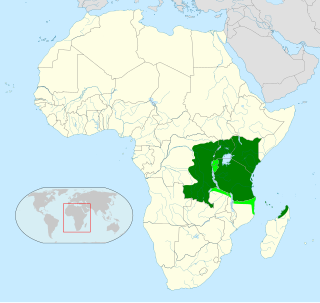Related Research Articles

Swahili, also known by its local name Kiswahili, is a Bantu language spoken by the Swahili people, who are found primarily in Tanzania, Kenya and Mozambique.

Makhuwa is the primary Bantu language of northern Mozambique. It is spoken by four million Makua people, who live north of the Zambezi River, particularly in Nampula Province, which is virtually entirely ethnically Makua. It is the most widely spoken indigenous language of Mozambique.
Yao is a Bantu language in Africa with approximately two million speakers in Malawi, and half a million each in Tanzania and Mozambique. There are also some speakers in Zambia. In Malawi, the main dialect is Mangochi, mostly spoken around Lake Malawi. In Mozambique, the main dialects are Makale and Massaninga. The language has also gone by several other names in English, including chiYao or ciYao, Achawa, Adsawa, Adsoa, Ajawa, Ayawa, Ayo, Ayao, Djao, Haiao, Hiao, Hyao, Jao, Veiao, and waJao.

Sena is a Bantu language spoken in the four provinces of central Mozambique : Tete, Sofala, Zambezia and Manica. There were an estimated 900,000 native Sena speakers in Mozambique in 1997, with at least 1.5 million if including those who speak it as a second language. It is one of the Nyasa languages.
Makonde, or Kimakonde, is the language spoken by the Makonde, an ethnic group in southeast Tanzania and northern Mozambique. Makonde is a central Bantu language closely related to Yao. The Matambwe (Matembwe) and Mabiha (Maviha) dialects are divergent, and may not be Makonde.
The Mwani language, also known by its native name Kimwani, is a Bantu language spoken on the coast of the Cabo Delgado Province of Mozambique, including the Quirimbas Islands. Although it shares high lexical similarity (60%) with Swahili, it is not intelligible with it. It is spoken by around 167,150 people. Speakers also use Portuguese, Swahili and Makhuwa language. Kiwibo, the dialect of the Island of Ibo is the prestige dialect. Kimwani is also called Mwani and Ibo. According to Anthony P. Grant Kimwani of northern Mozambique appears to be the result of imperfect shift towards Swahili several centuries ago by speakers of Makonde, and Arends et al. suggest it might turn out to be a Makonde–Swahili mixed language.
Bena is a Bantu language spoken by the Bena people of the Iringa region of Tanzania.
Chopi,, is a Bantu language spoken along the southern coast of Mozambique.
Nsenga, also known as Senga, is a Bantu language of Zambia, Malawi and Mozambique, occupying an area on the plateau that forms the watershed between the Zambezi and Luangwa river systems and Western Malawi land overshadowing Kachebere mountain called Mchinji.
The Zigula or Zigua language, Chizigua, is a Bantu language of Tanzania and Somalia, where the Mushunguli dialect is spoken.
The Lomwe (Lowe) language, Elomwe, also known as Western Makua, is the fourth-largest language in Mozambique. It belongs with Makua in the group of distinctive Bantu languages in the northern part of the country: The Makhuwa-using area proper is separated by a large Lomwe-speaking area from the related eChuwabo, although eMakhuwa neighbours eChuwabo in a more coastal zone. To the south, the rather more distantly related Sena (ChiSena) should be assigned to a group with Nyanja and Chewa, while the distinct group which includes Yao, Makonde and Mwera is found to the north. Apart from the regional variations found within eMakhuwa proper, eLomwe uses ch where tt appears in eMakhuwa orthography: for instance eMakhuwa mirette ("remedy") corresponds to eLomwe mirecce, eMakhuwa murrutthu to eLomwe miruchu, eMakhuwa otthapa ("joy") to eLomwe ochapa.
Mijikenda is a Bantu dialect cluster spoken along the coast of East Africa, mostly in Kenya, where there are 2.6 million speakers but also in Tanzania, where there are 166,000 speakers. The name Mijikenda means "the nine settlements" or "the nine communities" and refers to the multiple language communities that make up the group. An older, derogatory term for the group is Nyika which refers to the "dry and bushy country" along the coast.
Nyungwe is a Bantu language of Mozambique. It is used as a trade language throughout Tete Province.
Kunda (Chikunda) is a Bantu language of Zimbabwe, with a some thousands of speakers in Zambia and Mozambique.
Ilwana (Kiwilwana), or Malakote, is a minor Bantu language of Kenya.
The Tonga language of Mozambique, or Gitonga is a Bantu language spoken along the southern coast of the country. Often thought to be closest to Chopi to its south, the two languages have only a 44% lexical similarity.
Moniga, or Makhuwa-Moniga, is a Bantu language spoken by a quarter million Makua people in Mozambique. It is closely related to Cuabo.
Nathembo, or Sakati (Sangaji), is a Bantu language spoken by the Makua people of Mozambique.
Ngh’wele, or Kwere, is a Bantu language of the Morogoro and Dodoma regions of Tanzania.
References
- ↑ Chuwabo at Ethnologue (26th ed., 2023)

Maindo at Ethnologue (26th ed., 2023)
- ↑ Jouni Filip Maho, 2009. New Updated Guthrie List Online
- Guérois, Rozenn (2015). A grammar of Cuwabo (Mozambique, Bantu P34) (PhD thesis). Université Lumière Lyon 2. hdl:1854/LU-8561497.